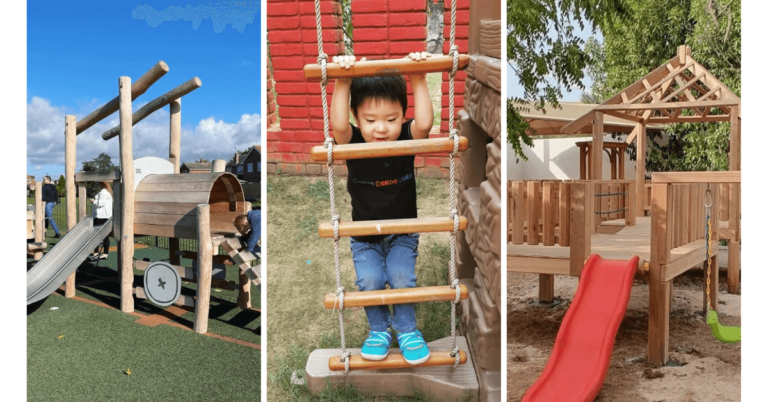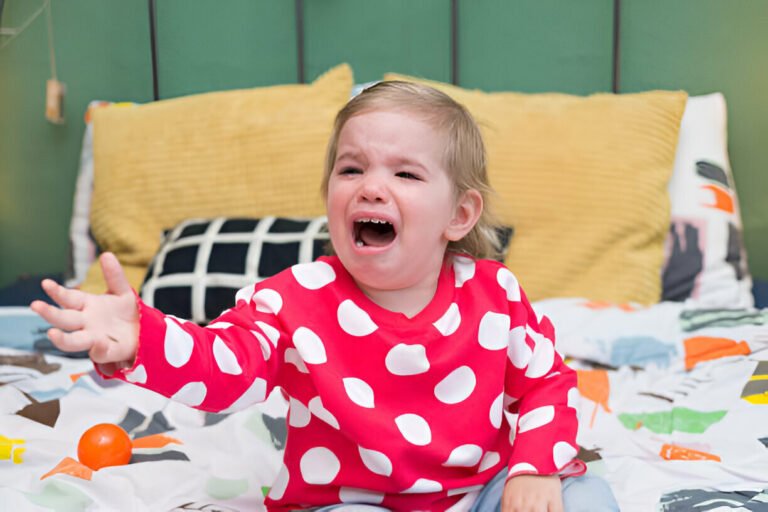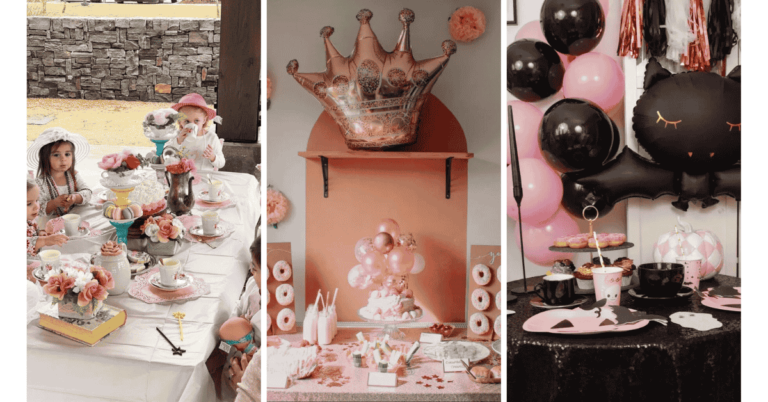17+ Toddler Playroom Ideas to Create a Fun & Safe Space
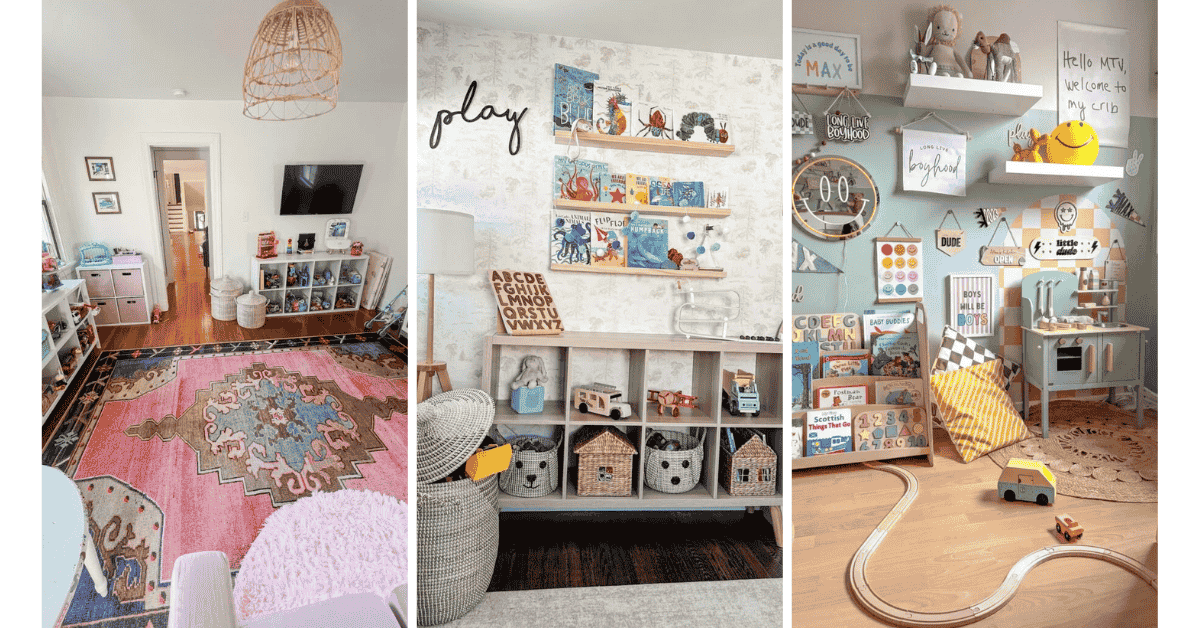
Creating a play area for toddlers isn’t just about keeping them busy it’s about building a world where imagination blooms, curiosity is nurtured, and safety is always top of mind.
Whether you’re working with a spacious backyard or a cozy corner in your living room, the right play setup can support your child’s development while filling their days with laughter and learning.
From soft zones for crawling to interactive sensory corners and mini climbing adventures, there are countless ways to design a toddler play space that’s both fun and functional.
In this article, we’ve gathered 17 inspired ideas to help you craft the perfect haven for your little one each one thoughtfully designed to spark creativity, encourage movement, and, most importantly, bring joy.
1- Creating a Multi-Level Play Paradise
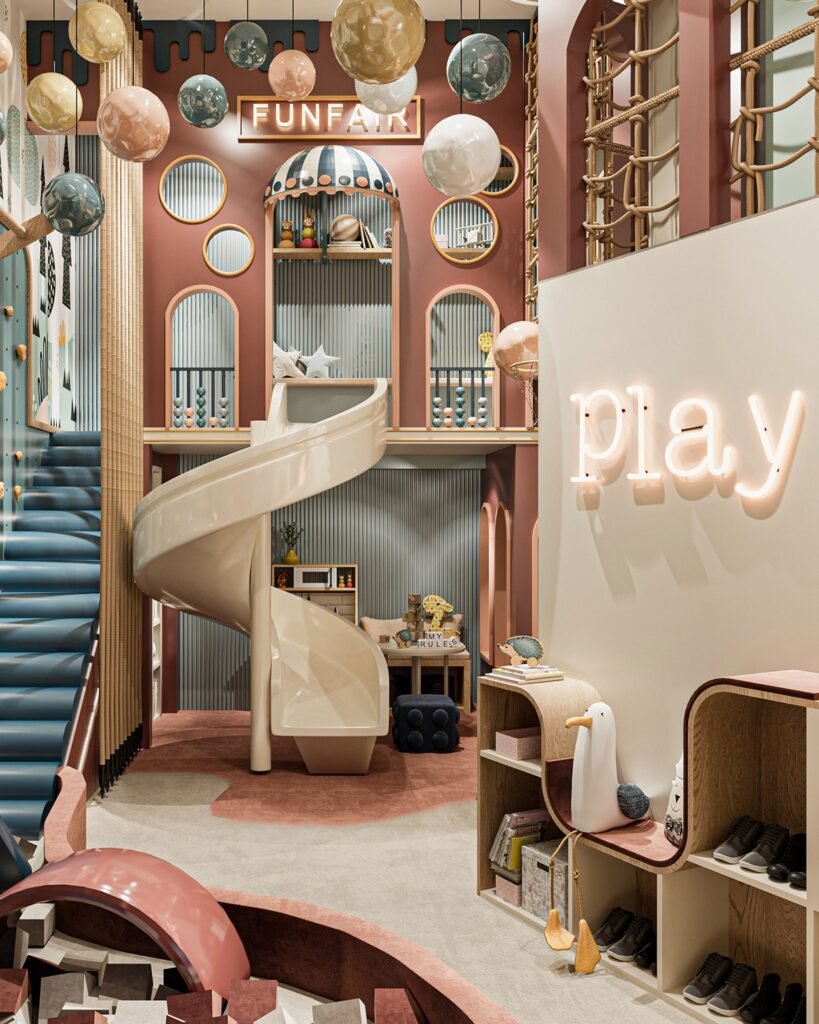
Imagine a playroom that sparks endless adventures! This vibrant space transforms playtime into a funfair experience with its whimsical slide, climbing stairs, and playful hanging decorations. The clever use of vertical space creates distinct zones for different activities, encouraging toddlers to explore and engage in imaginative play.
From zooming down the slide to peeking through the arched windows, every corner offers a new opportunity for discovery and active fun.
The thoughtful design extends to cozy nooks and organized storage, ensuring that the excitement doesn’t lead to chaos. Soft rugs and rounded edges prioritize safety, while the playful color palette and engaging textures stimulate young senses.
This multi-level concept proves that even indoor play can be an exhilarating and enriching experience for toddlers, fostering both physical activity and creative exploration within a secure environment.
2. Whimsical Play Cottage
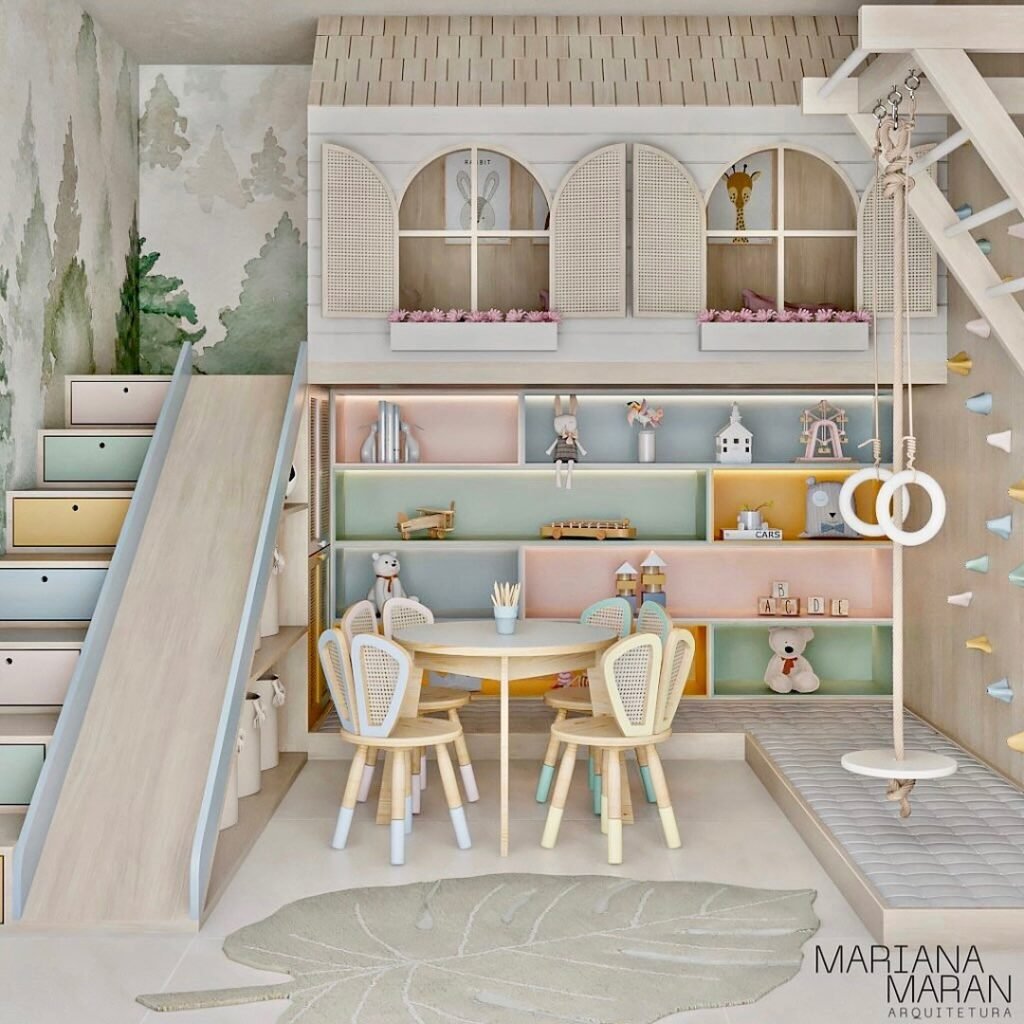
Step into a fairytale! This enchanting playroom features a delightful play cottage as its centerpiece, sparking imaginative scenarios and storytelling.
The soft pastel hues, natural wood accents, and floral touches evoke a sense of warmth and tranquility, creating a soothing yet stimulating environment. Details like window boxes and shuttered windows add to the cottage’s charm, inviting toddlers into their own little world.
Beyond the cottage, the playroom offers a balanced blend of activities with a slide, climbing elements, and a cozy table for creative projects. Open shelving displays toys in an accessible and visually appealing way, encouraging independence and organization.
This cottagecore-inspired design demonstrates how a dedicated play structure can become a focal point for imaginative play, fostering creativity and social interaction in a beautiful setting.
3. Designing a Calm and Engaging Montessori Playroom
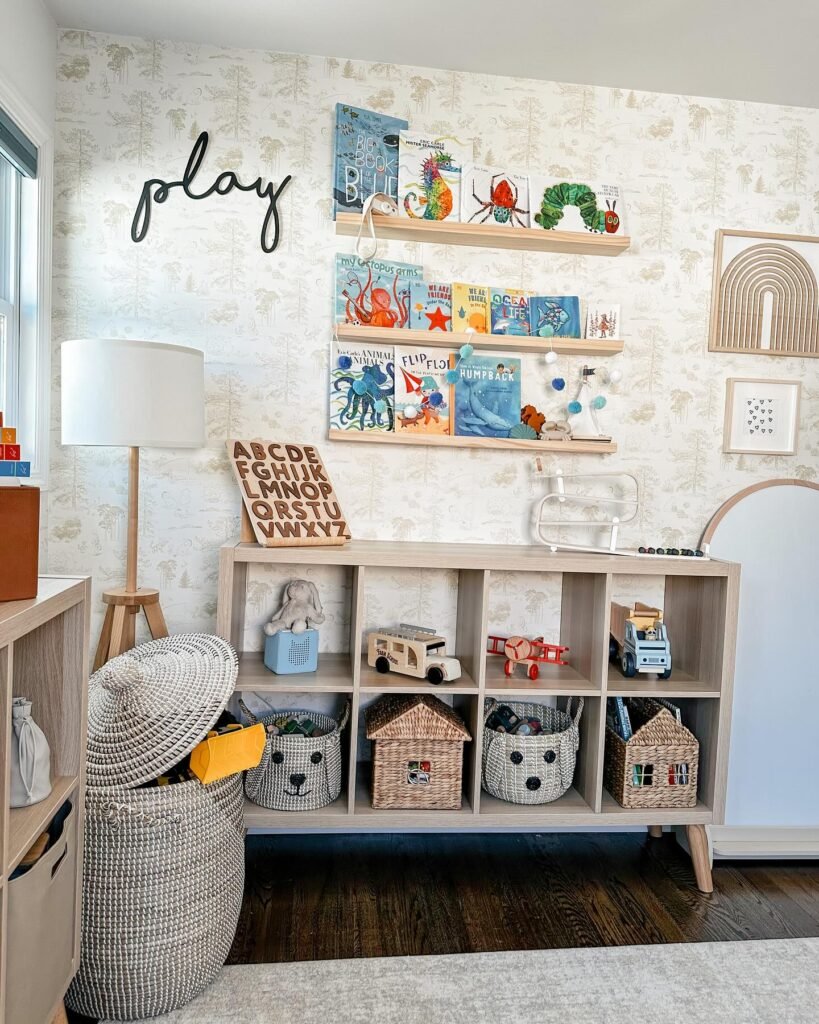
This serene playroom embraces a Montessori approach, focusing on simplicity, order, and child-led exploration. Natural materials, soft lighting, and a neutral color palette create a calming atmosphere conducive to concentration and independent learning.
Carefully selected toys and books are displayed accessibly, inviting toddlers to make their own choices and engage at their own pace.
The inclusion of open shelving with organized baskets promotes a sense of order and responsibility. A designated reading nook with engaging books encourages literacy, while open floor space allows for movement and various activities.
This design philosophy highlights the beauty of a clutter-free environment that fosters focus, creativity, and a love of learning in young children.
4. Crafting a Playroom with Timeless Wooden Toys
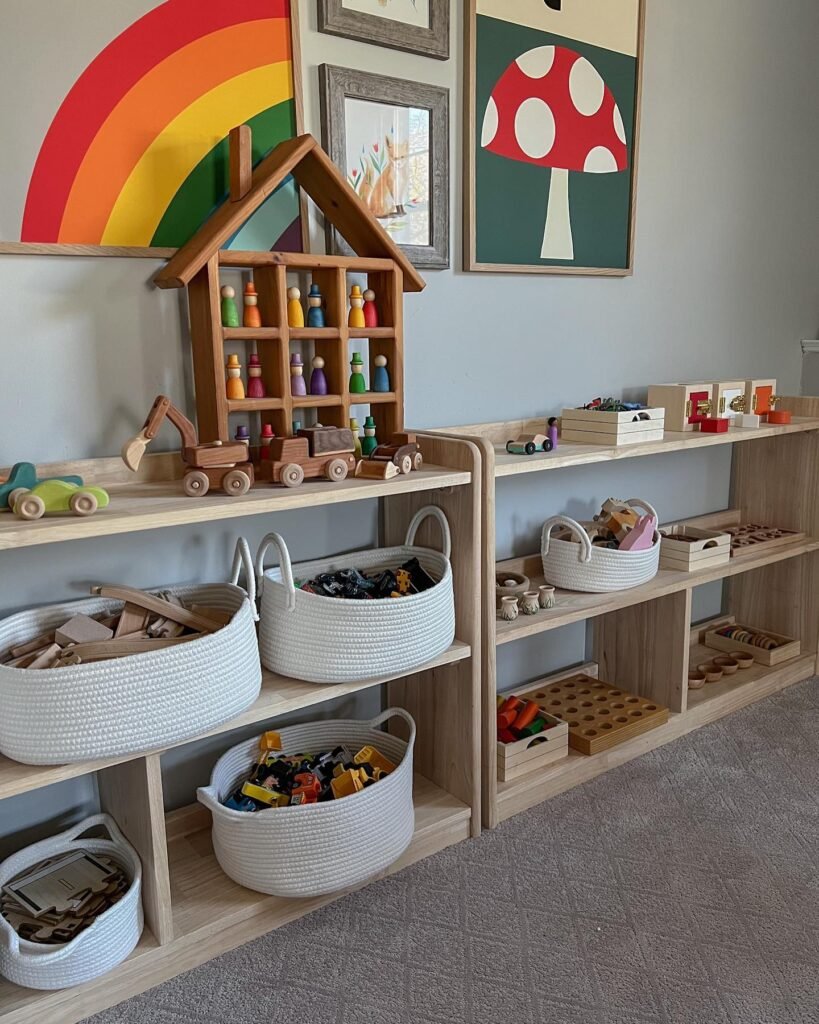
Embrace the beauty of simplicity with this playroom centered around open-ended wooden toys. Shelves are filled with natural blocks, vehicles, and figures, encouraging toddlers to engage in imaginative construction, storytelling, and problem-solving.
The absence of overly stimulating electronics allows children to focus on tactile exploration and develop their creativity through hands-on play.
The uncluttered space and neutral tones create a calming backdrop that allows the toys to take center stage. Baskets provide easy storage solutions, promoting organization and independence.
This approach emphasizes the value of classic toys in fostering imagination, fine motor skills, and cognitive development in a visually appealing and sustainable way.
5. Creating a Miniature World with a Play House
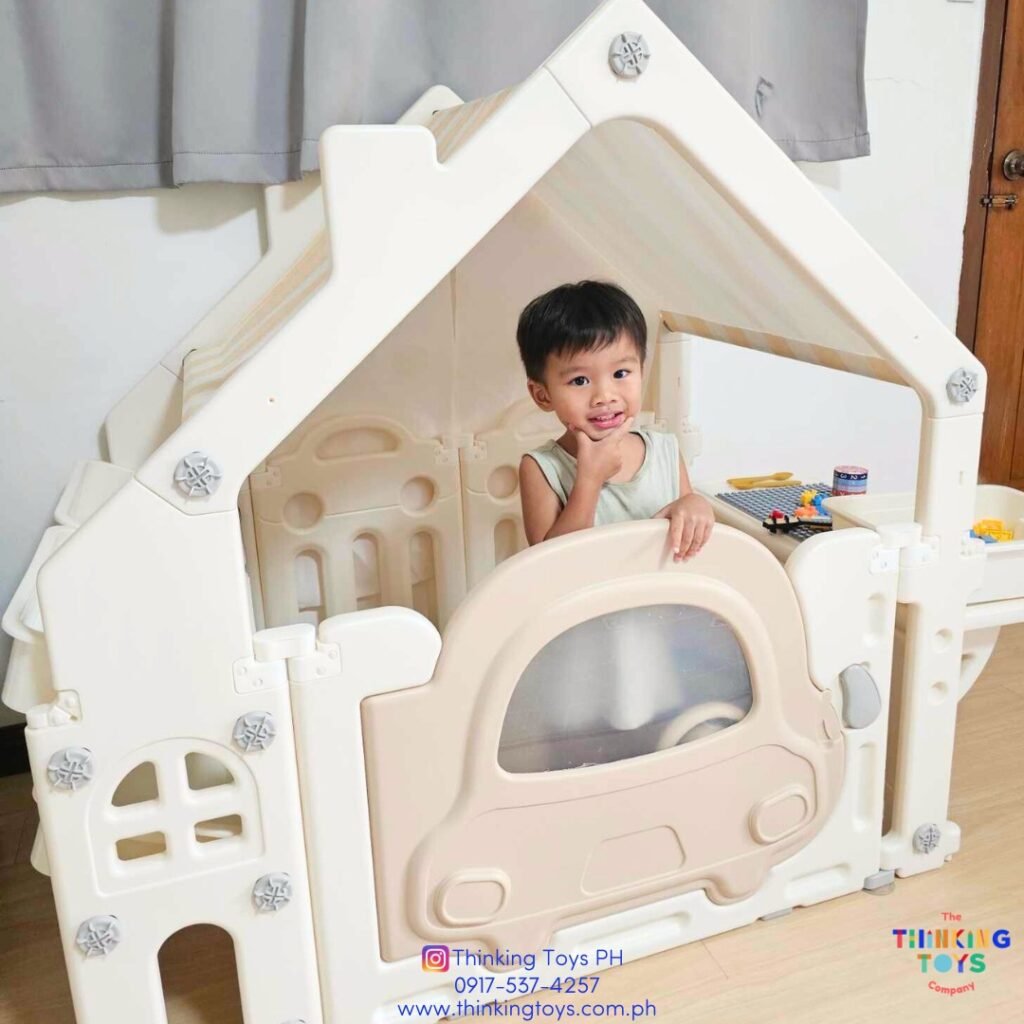
This adorable play house provides a toddler with their very own independent space for imaginative role-playing and solo adventures. Its compact design makes it perfect for smaller rooms, yet it offers a world of possibilities for young minds. The car-shaped door adds a touch of whimsy, inviting children into their private haven.
Inside, a small table and seating area encourage creative activities and quiet play. The open design allows for easy supervision while still providing a sense of enclosure and ownership for the child.
This charming play house demonstrates how a dedicated, child-sized structure can foster independence, creativity, and a sense of belonging within the playroom.
6. Designing a Playroom Bursting with Individuality
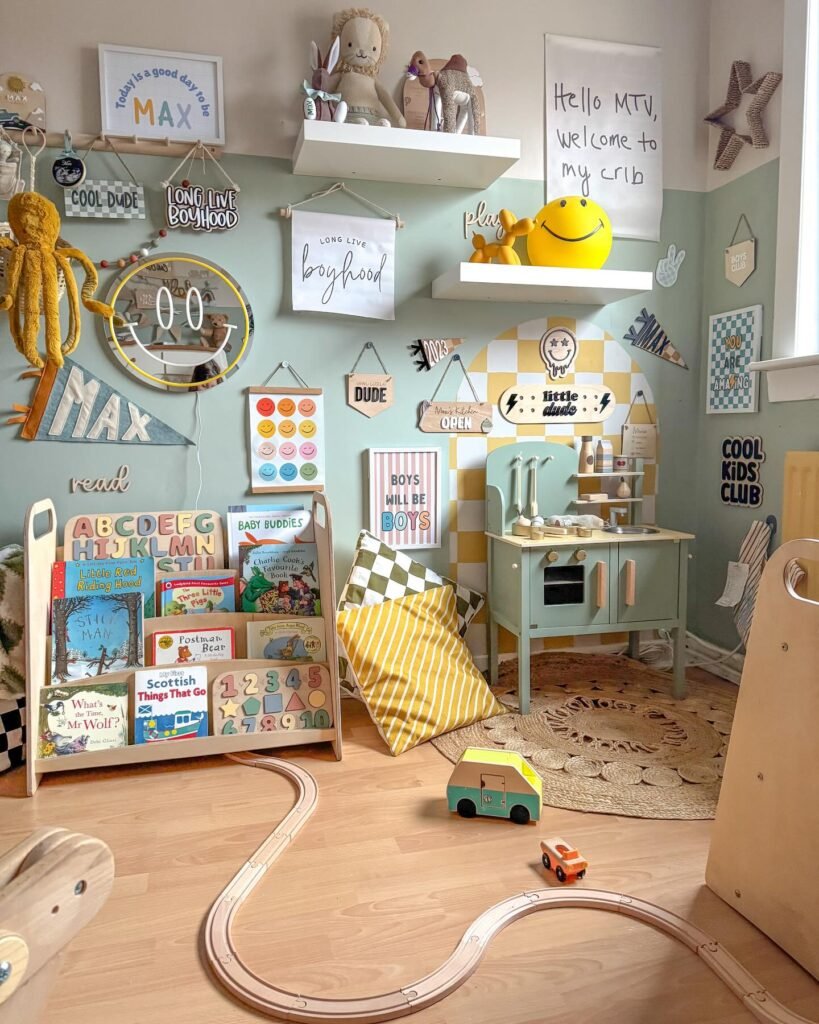
Vibrant and eclectic playroom is a testament to a child’s unique personality and interests. Walls adorned with playful decorations, artwork, and inspiring messages create a stimulating and joyful atmosphere. The mix of colors, patterns, and textures adds a sense of fun and encourages visual exploration.
Different play zones are thoughtfully arranged, from a reading nook filled with engaging books to a pretend play kitchen and a train track winding across the floor. Open shelves display a variety of toys and collectibles, reflecting the child’s passions.
This design philosophy celebrates individuality and demonstrates how a playroom can be a dynamic and ever-evolving reflection of a child’s growing world.
7. Calming Oasis for Creative Play
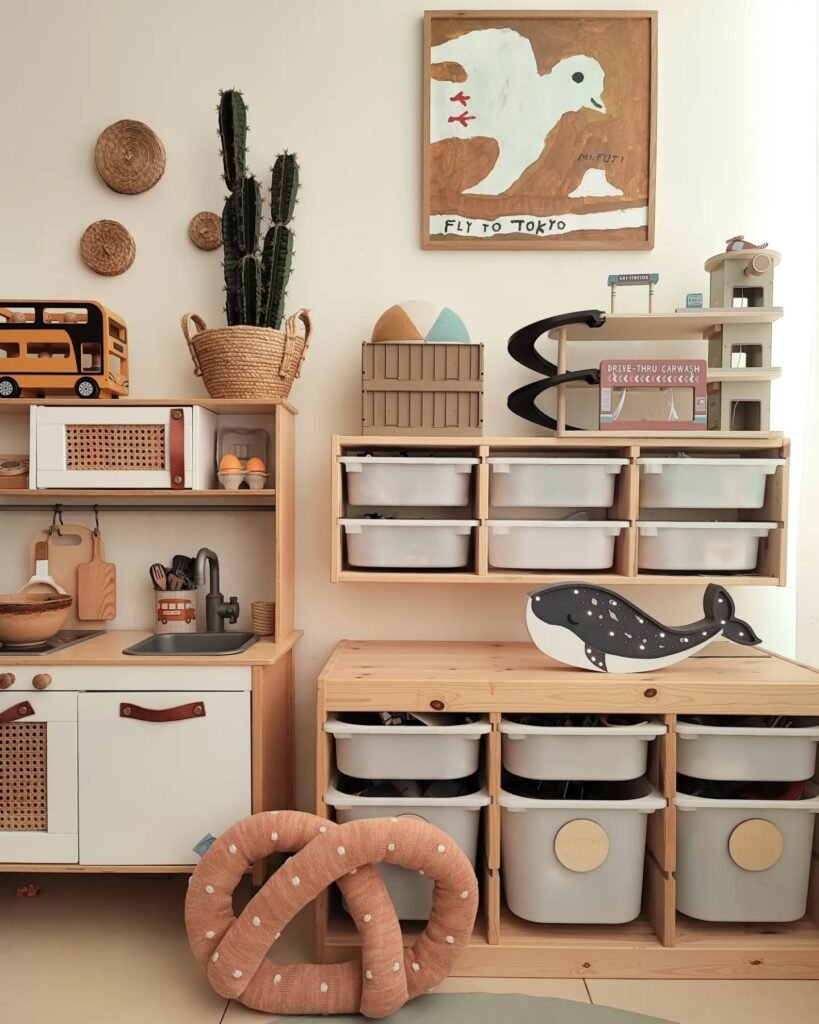
This calming playroom embraces a natural and neutral aesthetic, fostering a sense of peace and focus. Wooden furniture, woven textures, and soft, earthy tones create a soothing environment that encourages mindful play. The incorporation of plants and natural light further enhances the tranquil atmosphere.
Despite its simplicity, the playroom offers a variety of engaging activities, including a play kitchen and organized storage for open-ended toys. The emphasis on natural materials and a clutter-free space promotes sensory exploration and imaginative play without overwhelming young minds.
This design highlights the beauty of a minimalist approach in creating a harmonious and stimulating playroom.
8. Designing an Active Soft Play Zone at Home
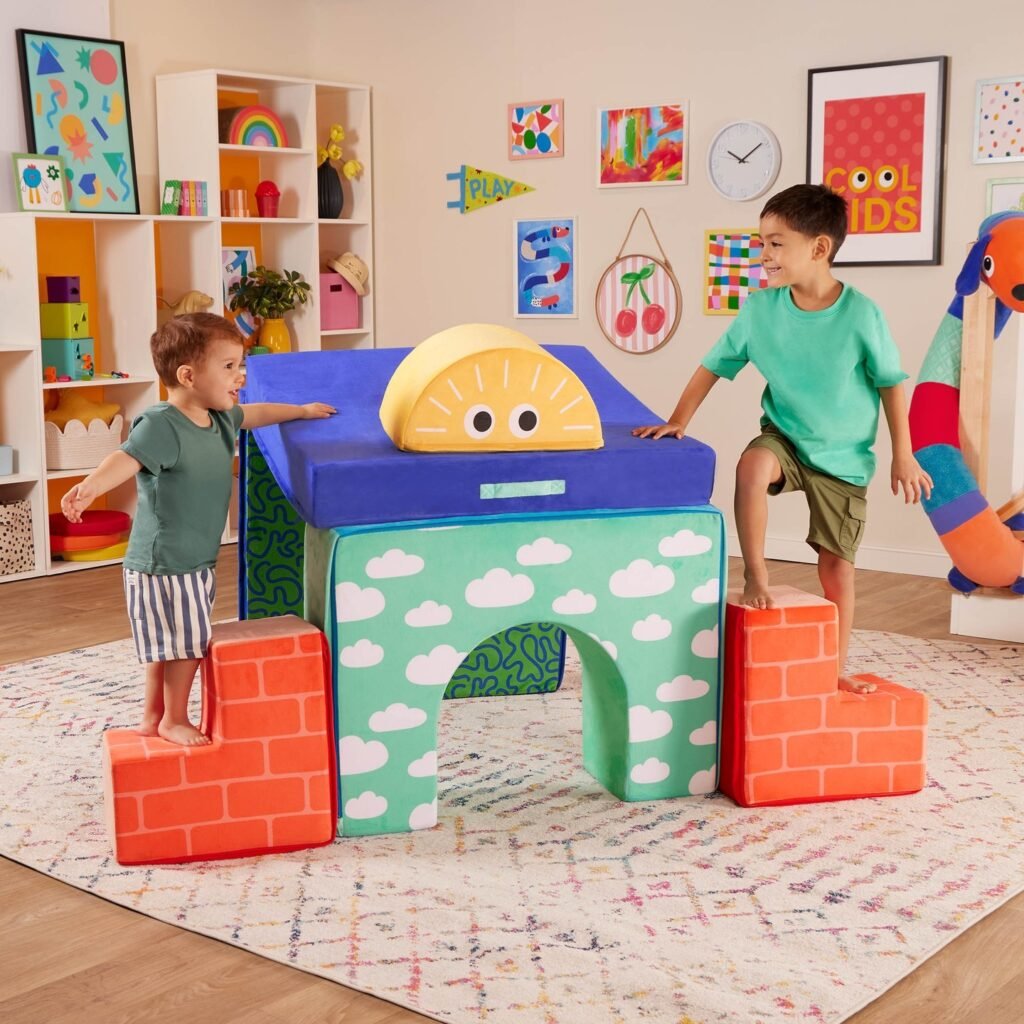
This dynamic playroom prioritizes movement and physical activity with its engaging soft play structures. Colorful blocks, tunnels, and climbing elements invite toddlers to jump, crawl, and build, expending energy in a safe and fun environment. The soft materials ensure a cushioned landing for adventurous play.
The open layout encourages movement and interaction, making it ideal for playdates and group activities. The vibrant colors and playful shapes stimulate visual senses and encourage imaginative scenarios.
This design demonstrates how to create an indoor space that caters to the physical needs of active toddlers, promoting gross motor skills and joyful movement.
9. Crafting a Playroom with Whimsical Touches
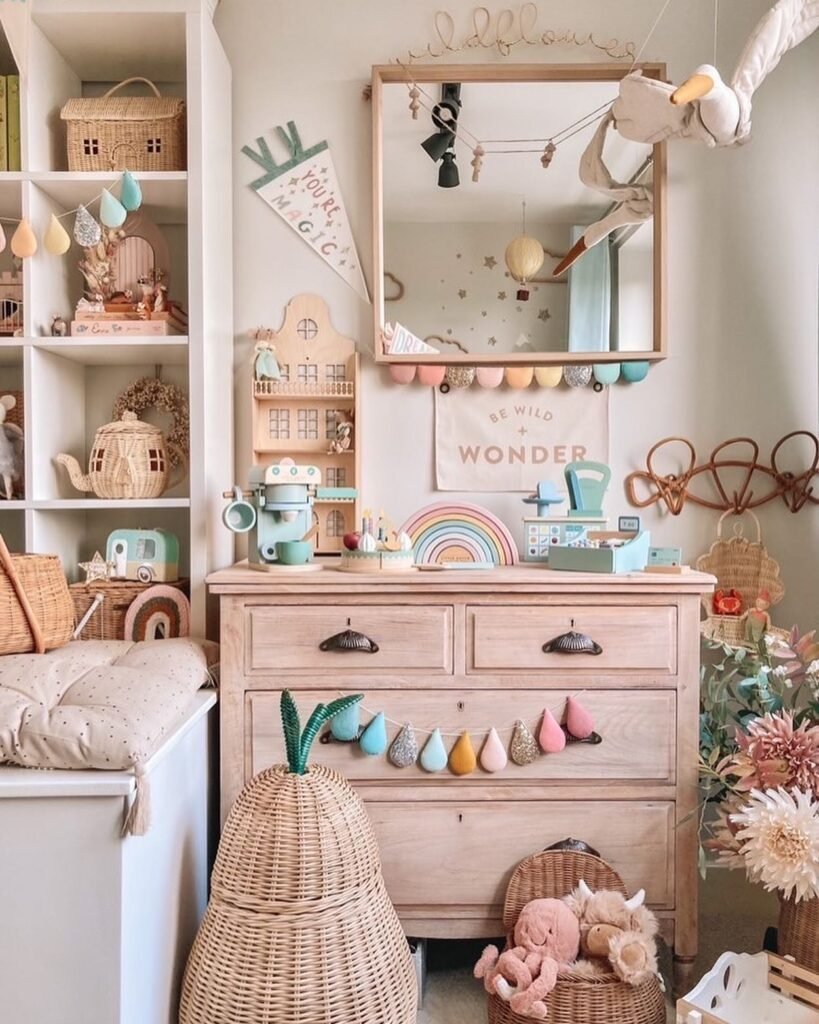
This charming playroom is filled with enchanting details that spark imagination and wonder. Delicate garlands, whimsical wall decorations, and carefully curated toys create a magical atmosphere. Natural materials like wood and wicker add warmth and texture to the space.
The inclusion of a play kitchen, a dollhouse, and open shelves displaying beautiful toys encourages imaginative role-playing and storytelling. Soft cushions and cozy corners invite quiet moments of reflection and reading.
This design philosophy emphasizes the power of small, thoughtful details in creating a playroom that feels like a truly special and inspiring place for young children.
10. Designing a Simple and Adaptable Playroom for Toddlers
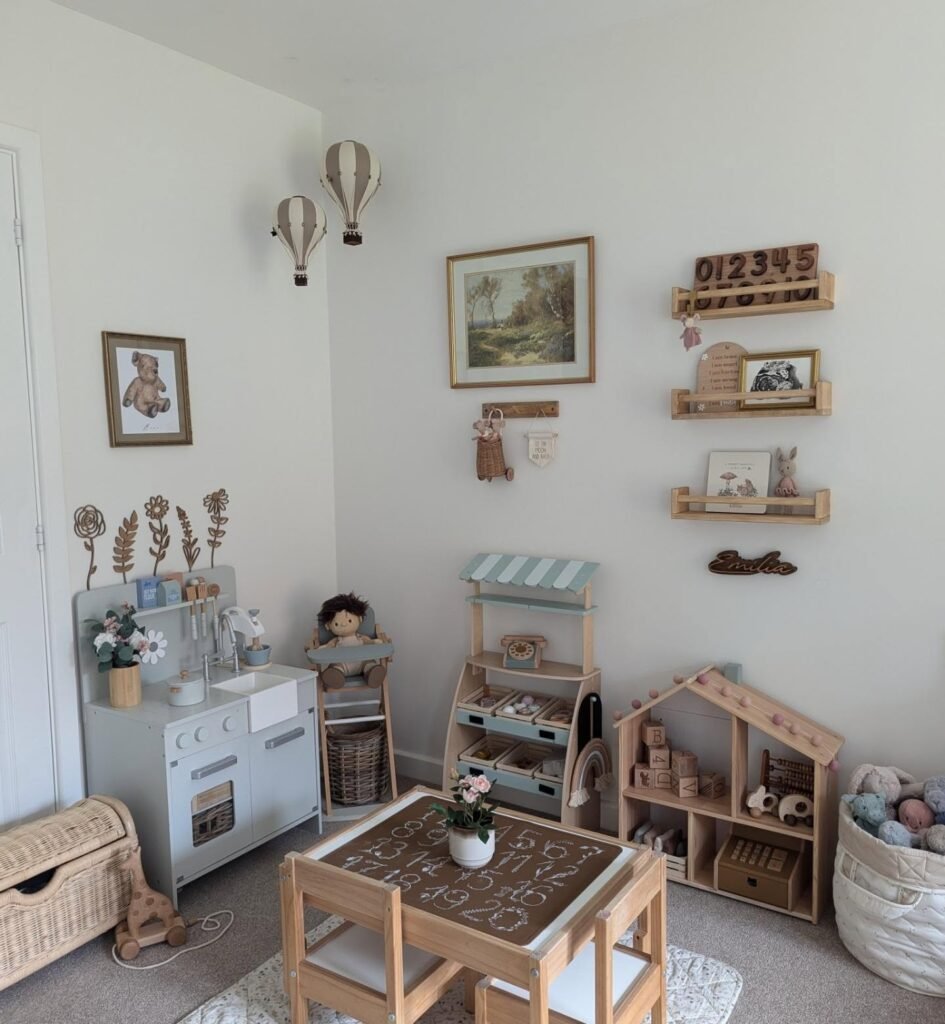
Clean and uncluttered playroom focuses on functionality and adaptability, providing a versatile space that can evolve with a child’s growing needs. Neutral walls and simple furniture create a blank canvas that allows toys and activities to take center stage. Open shelves and accessible storage solutions promote organization and independence.
The inclusion of a play kitchen, a table for creative activities, and open floor space allows for a variety of play styles. The emphasis on essential pieces ensures that the playroom remains manageable and easy to navigate for young children.
This design philosophy highlights the beauty of simplicity in creating a practical and stimulating environment that can adapt to a toddler’s changing interests and developmental stages.
11. World of Gentle Learning
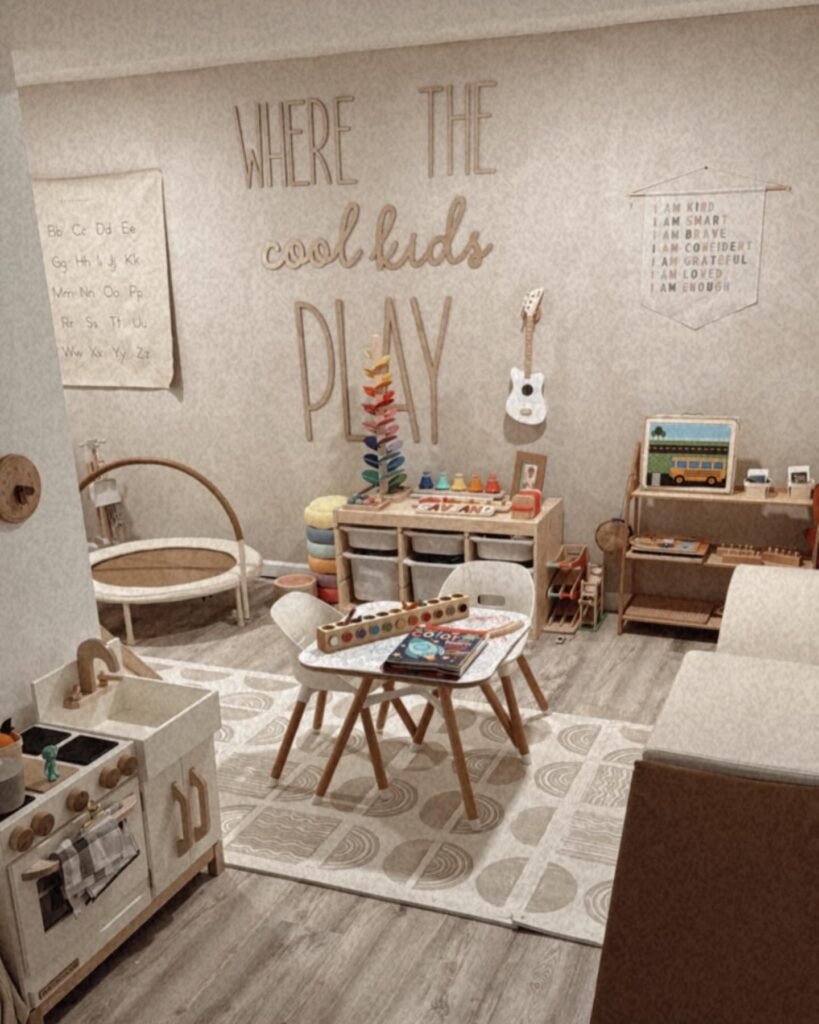
Serene playroom design prioritizes a calm and organized environment, fostering a love of learning through accessible and engaging materials.
The intentional layout features distinct zones for various activities, such as a dedicated art and writing area with an alphabet chart, a sensory exploration station with colorful stacking toys, and a cozy reading nook with a comfortable arch rocker. The neutral color palette and natural wood elements create a soothing backdrop that allows the toys and learning materials to stand out.
The thoughtful inclusion of low shelving and open storage encourages independence, allowing toddlers to easily access and tidy up their playthings. Educational elements are seamlessly integrated, promoting early literacy, numeracy, and fine motor skills in a playful manner.
This approach demonstrates how a well-organized and intentionally designed playroom can nurture a child’s natural curiosity and love of learning.
12. Warm and Imaginative Toddler Space
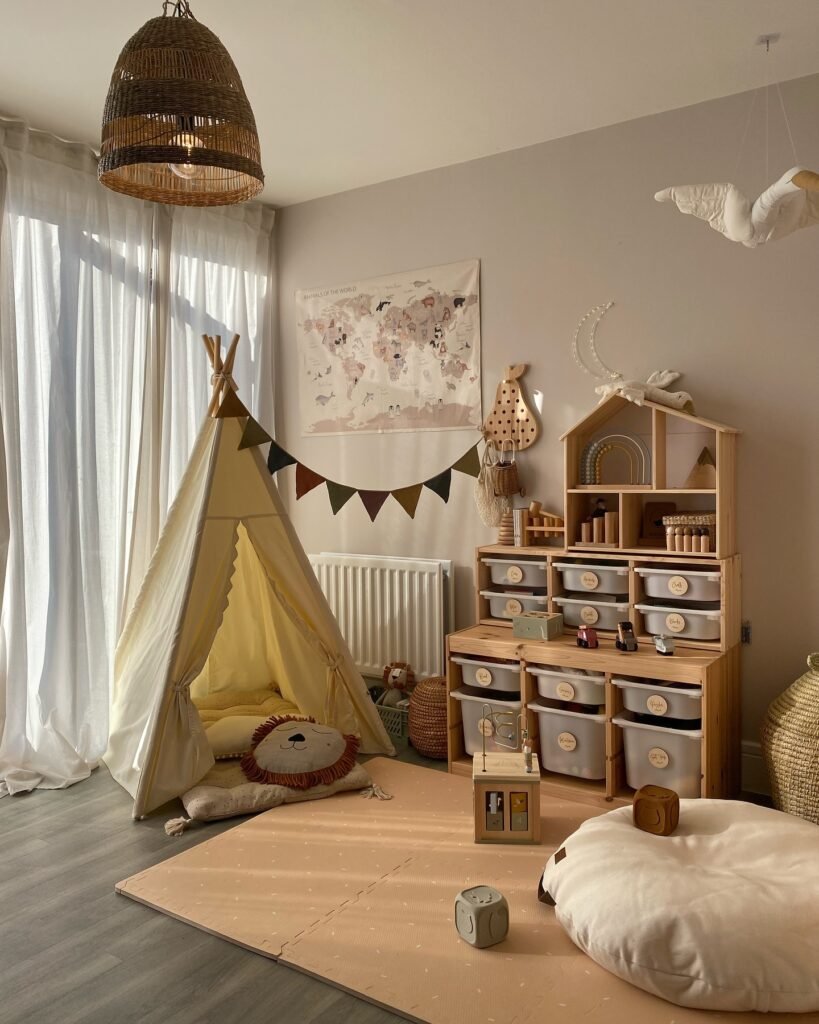
This inviting playroom design emphasizes comfort and imagination, featuring a charming teepee as a cozy retreat for quiet play and storytelling. Soft textures, warm lighting from a woven pendant lamp, and a plush floor mat create a welcoming atmosphere.
A world map tapestry subtly introduces geographical awareness, while whimsical decorations like a hanging swan and a moon-shaped shelf add a touch of magic.
The wooden storage unit with labeled drawers promotes organization and accessibility, allowing toddlers to independently manage their toys. The open floor space encourages movement and imaginative play scenarios.
The design highlights the importance of creating a dedicated space where toddlers feel safe, inspired, and free to explore their creativity.
13. Colorful and Engaging Playroom for Active Toddlers
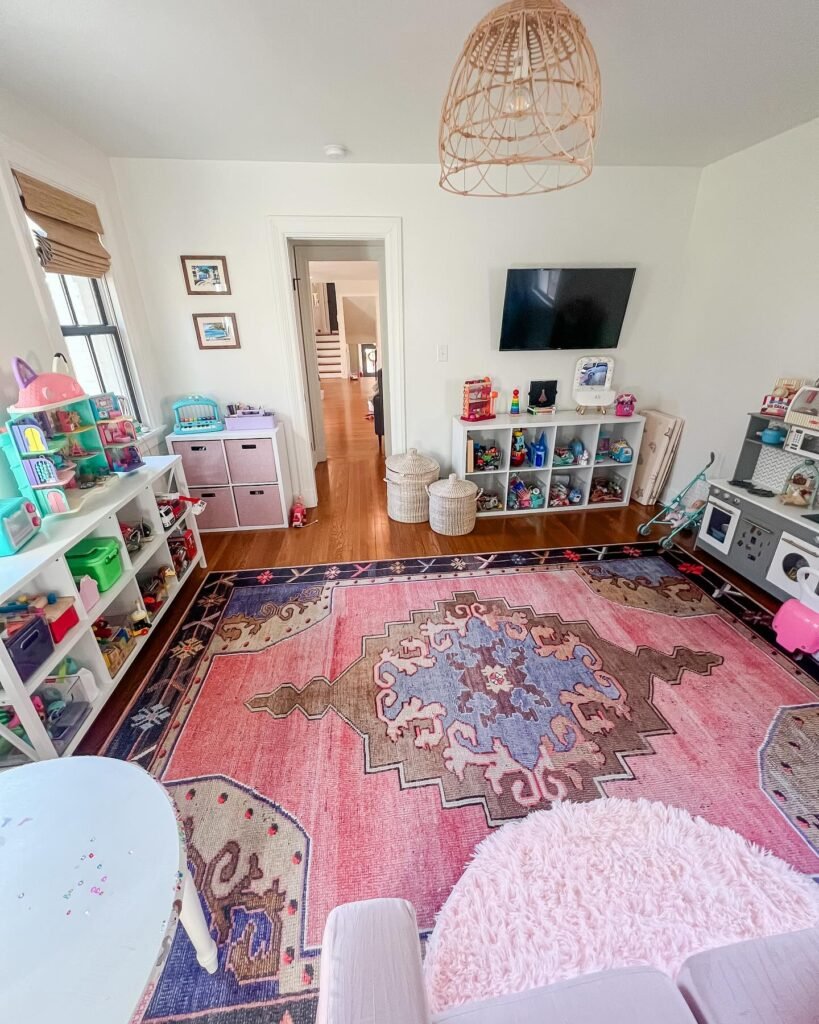
Lively playroom is a vibrant hub of activity, featuring a rich color palette and distinct zones for various types of play. A plush pink rug anchors the space, while colorful shelving units display a wide array of toys, encouraging exploration and choice.
The inclusion of a play kitchen and a designated area with a television suggests a balance between active and quieter forms of entertainment.
The open layout promotes movement and interaction, making it an ideal space for playdates. The mix of textures and patterns adds visual interest and stimulates sensory exploration.
This design demonstrates how a well-defined yet open playroom can cater to the diverse interests and energy levels of active toddlers, fostering both independent and social play.
14. Neutral and Stimulating Toddler Playroom
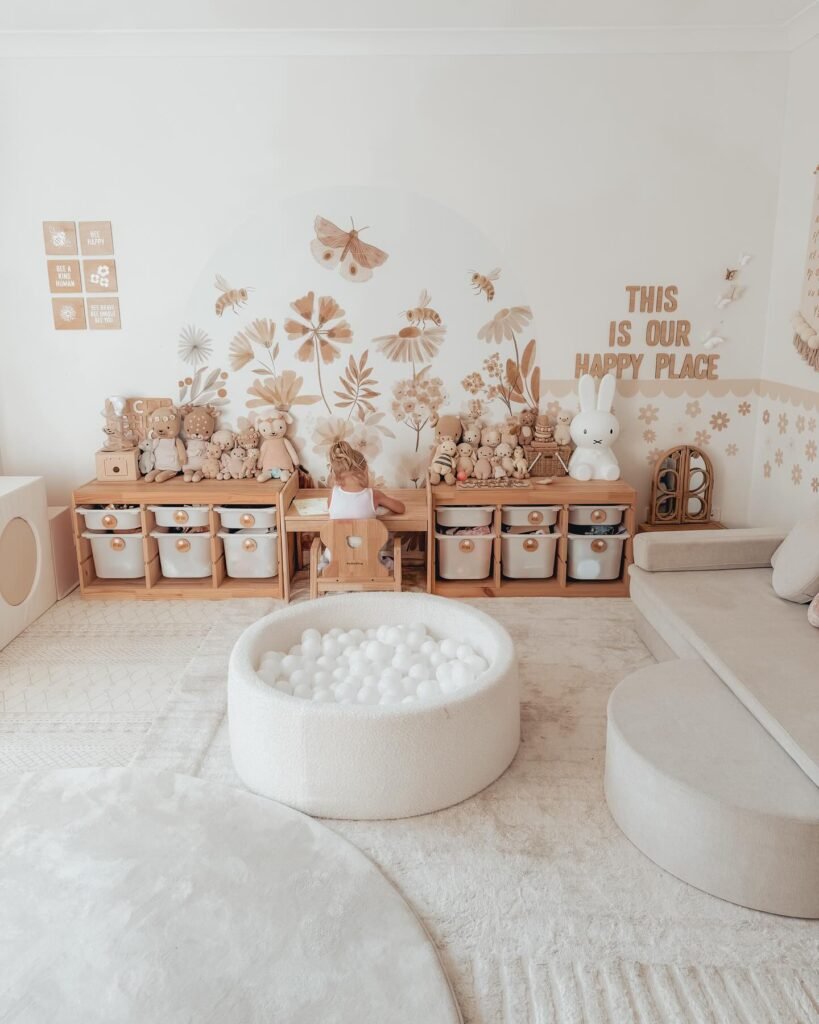
This serene playroom design draws inspiration from nature, featuring a neutral color palette, natural wood furniture, and organic-themed wall decals. The open layout encourages movement and exploration, with a cozy ball pit offering a sensory experience. Low shelving units filled with neatly organized bins provide easy access to a variety of toys.
The inclusion of a child-sized table and chairs creates a dedicated space for creative activities and focused play. The abundance of soft toys suggests a focus on comfort and imaginative role-playing.
This design highlights how a naturally inspired and well-organized playroom can foster creativity, independence, and a sense of calm.
15. Dynamic Playroom Designed for Movement and Fun
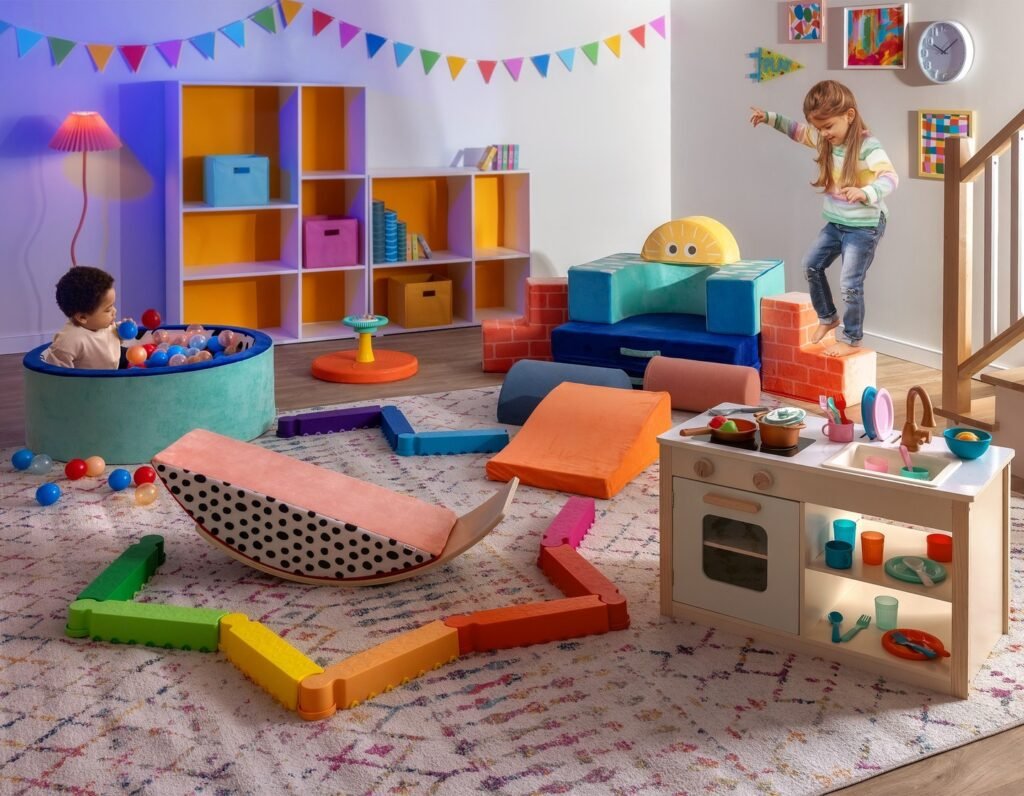
This vibrant and dynamic playroom is designed to encourage physical activity and imaginative play. Soft play equipment like climbing blocks, a rocker, and colorful tunnels invite toddlers to move, build, and explore safely. A ball pit adds a fun sensory element, while a play kitchen encourages role-playing.
The open layout and bright colors create an energetic and stimulating environment. Clearly defined storage solutions help to contain the excitement and maintain a sense of order.
This design demonstrates how to transform a playroom into an indoor playground, catering to the active nature of toddlers and promoting gross motor skill development.
16. Minimalist Sanctuary of Play
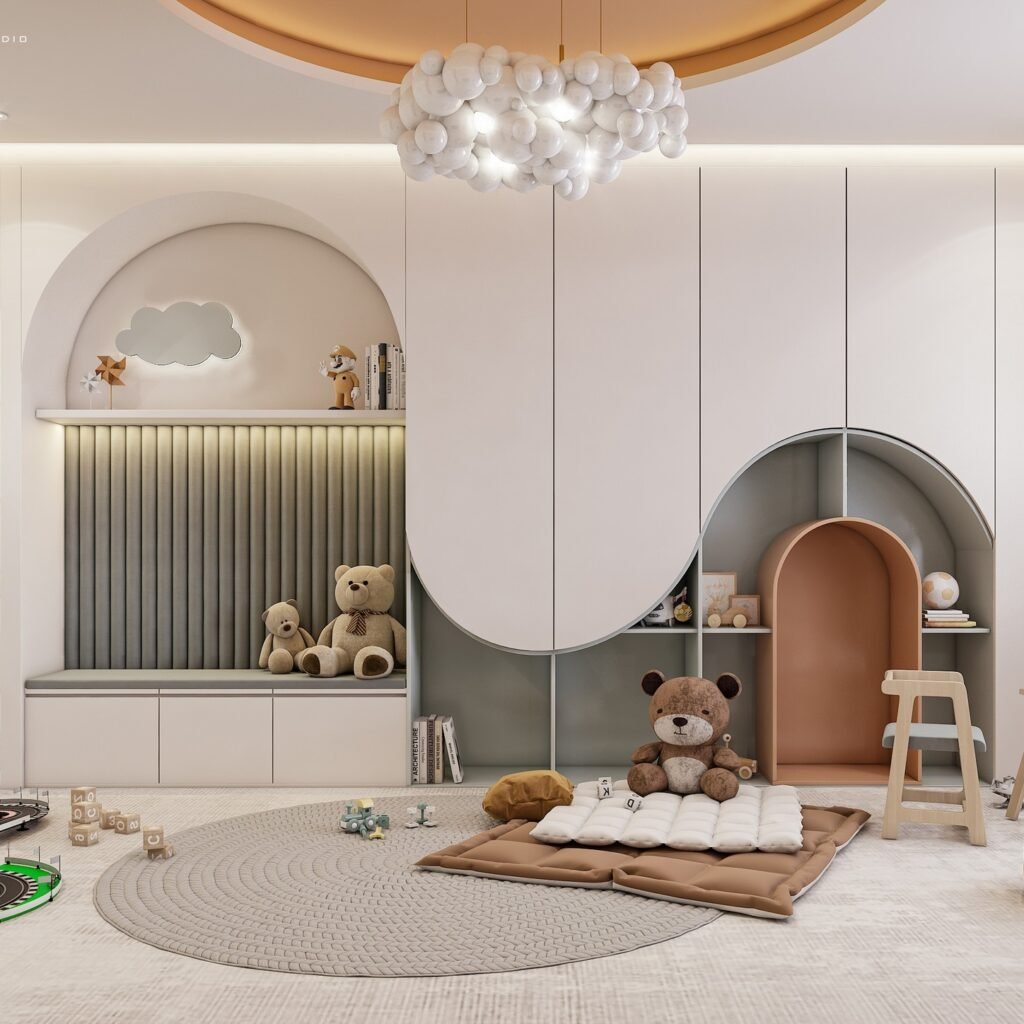
Sophisticated playroom design embraces a minimalist aesthetic with a focus on clean lines, neutral colors, and carefully selected toys. Built-in shelving with arched niches creates visually appealing storage and display areas. Soft lighting and a round rug define the play space, fostering a sense of calm and focus.
The intentional selection of open-ended toys encourages creativity and imaginative play without overwhelming the space. A cozy floor cushion and a small table offer comfortable spots for quiet activities.
This design highlights how a thoughtfully curated and minimalist playroom can be both stylish and stimulating for young children.
17. Zones of Discovery Play Room
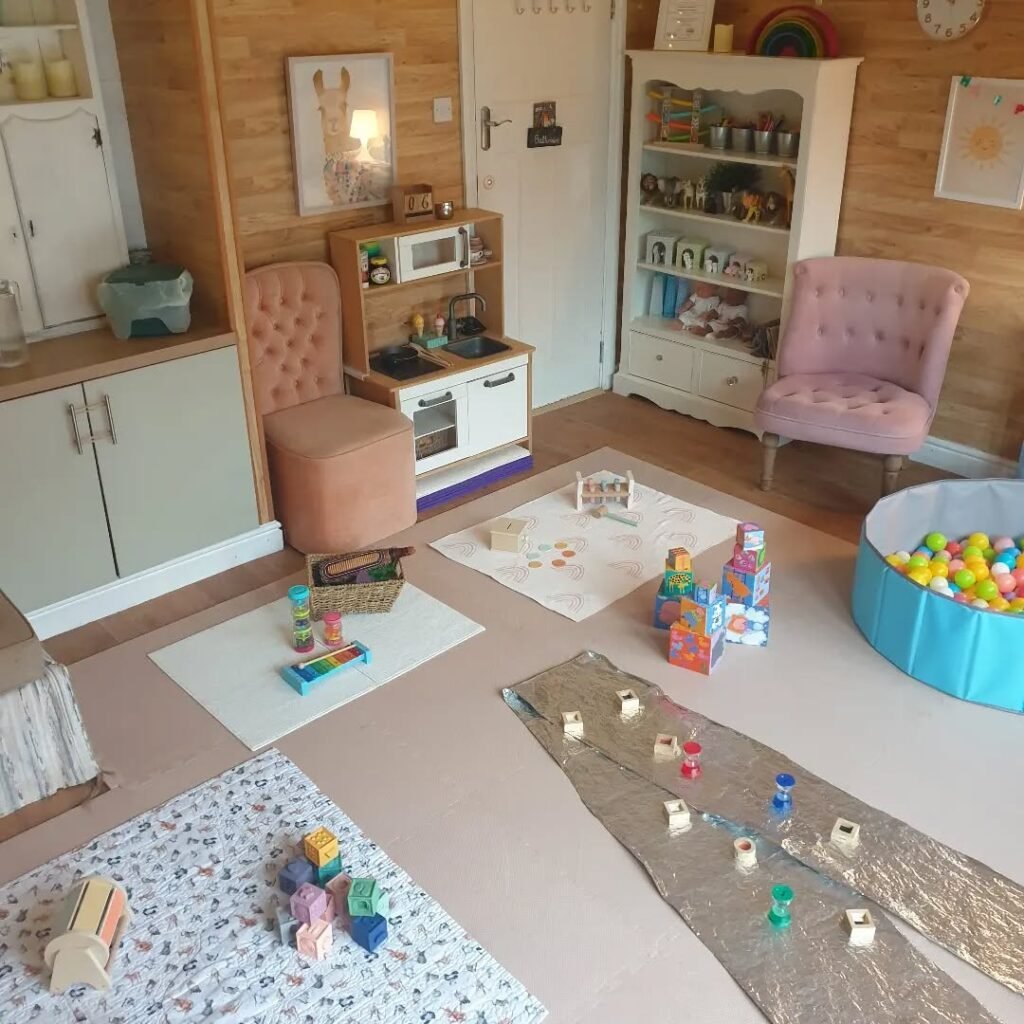
The thoughtfully arranged toddler playroom demonstrates the power of creating distinct zones to cater to different types of play. A charming play kitchen occupies one corner, encouraging imaginative role-playing and culinary adventures. Soft, plush armchairs define a cozy reading or quiet play area, inviting relaxation and focus.
The open floor space is cleverly divided with play mats, each hosting different activities. One mat features building blocks, promoting construction and fine motor skills, while another showcases musical instruments, fostering creativity and auditory development.
A ball pit in another zone offers a fun sensory experience and encourages gross motor skills. This zoning strategy helps toddlers understand and engage with different types of play in a structured yet manner, maximizing engagement and minimizing clutter.
Conclusion:
Designing a toddler play area is a beautiful opportunity to see the world through your child’s eyes full of wonder, movement, and endless possibilities. Whether you choose nature-themed nooks, imaginative indoor zones, or Montessori-inspired layouts, each of these 17 ideas offers a way to create a meaningful space that encourages play, growth, and connection.
The best play areas don’t have to be big or expensive they just need to be built with love, intention, and a deep understanding of what lights up your child’s world. So let your creativity lead the way, and build a space where tiny adventures happen every day.

